
RESEARC H Open Access
Evaluation of the anti-angiogenic properties of
the new selective a
V
b
3
integrin antagonist
RGDechiHCit
Gaetano Santulli
1
, Maria Felicia Basilicata
1
, Mariarosaria De Simone
2
, Carmine Del Giudice
1
, Antonio Anastasio
1
,
Daniela Sorriento
1
, Michele Saviano
3
, Annarita Del Gatto
4
, Bruno Trimarco
1
, Carlo Pedone
2
, Laura Zaccaro
4
,
Guido Iaccarino
1*
Abstract
Background: Integrins are heterodimeric receptors that play a critical role in cell-cell and cell-matrix adhesion
processes. Among them, a
V
b
3
integrin, that recognizes the aminoacidic RGD triad, is reported to be involved in
angiogenesis, tissue repair and tumor growth. We have recently synthesized a new and selective ligand of a
V
b
3
receptor, referred to as RGDechiHCit, that contains a cyclic RGD motif and two echistatin moieties.
Methods: The aim of this study is to evaluate in vitro and in vivo the effects of RGDechiHCit. Therefore, we
assessed its properties in cellular (endothelial cells [EC], and vascular smooth muscle cells [VSMC]) and animal
models (Wistar Kyoto rats and c57Bl/6 mice) of angiogenesis.
Results: In EC, but not VSMC, RGDechiHCit inhibits intracellular mitogenic signaling and cell proliferation.
Furthermore, RGDechiHCit blocks the ability of EC to form tubes on Matrigel. In vivo, wound healing is delayed in
presence of RGDechiHCit. Similarly, Matrigel plugs demonstrate an antiangiogenic effect of RGDechiHCit.
Conclusions: Our data indicate the importance of RGDechiHCit in the selective inhibition of endothelial a
V
b
3
integrin in vitro and in vivo. Such inhibition opens new fields of investigation on the mechanisms of angiogenesis,
offering clinical implications for treatment of pathophysiological conditions such as cancer, proliferative retinopathy
and inflammatory disease.
Introduction
Angiogenesis is a complex multistep phenomenon con-
sisting of the sprouting and the growth of new capillary
blood vessels starting from the pre-existing ones. It
requires the cooperation of several cell types such as
endothelial cells (ECs), vascular smooth muscle cells
(VSMCs), macrophages, which should be activated, pro-
liferate and migrate to invade the extracellular matrix
and cause vascular remodeling [1,2]. The angiogenic
processisfinelytunedbyaprecisebalanceofgrowth
and inhibitory factors and in mammalians it is normally
dormant except for some physiological conditions, such
as wound healing and ovulation. When this balance is
altered, excessive or defective angiogenesis occur and
the process becomes pathological. Excessive angiogen-
esis gives also rise to different dysfunctions, including
cancer, eye diseases, rheumatoid arthritis, atherosclero-
sis, diabetic nephropathy, inflammatory bowel disease,
psoriasis, endometriosis, vasculitis, and vascular malfor-
mations [3]. Therefore the discovery of angiogenesis
inhibitors would contribute to the development of thera-
peutic treatments for these diseases.
The integrins are cell adhesion receptors that mediate
cell-cell and cell-matrix interactions and coordinate sig-
naling allowing a close regulation of physiological phe-
nomena including cellular migration, proliferation and
differentiation. In particular, the a
V
integrins, combined
with distinct bsubunits, participate in the angiogenic
process. An extensively studied member of this receptor
class is integrin a
V
b
3
, that is strongly overexpressed in
* Correspondence: guiaccar@unina.it
1
Department of Clinical Medicine, Cardiovascular & Immunologic Sciences,
“Federico II”University of Naples, Italy
Full list of author information is available at the end of the article
Santulli et al.Journal of Translational Medicine 2011, 9:7
http://www.translational-medicine.com/content/9/1/7
© 2011 Santulli et al; licensee BioMed Central Ltd. This is an Open Access article distributed under the terms of the Creative Commons
Attribution License (http://creativecommons.org/licenses/by/2.0), which permits unrestricted use, distribution, and reproduction in
any medium, provided the original work is properly cited.

activated EC, melanoma, glioblastoma and prostate can-
cers and in granulation tissue, whereas is not detectable
in quiescent blood vessels or in the dermis and epithe-
lium of normal skin [4-6]. This integrin participates in
the activation of vascular endothelial growth factor
receptor-2 (VEGFR-2), providing a survival signal to the
proliferating vascular cells during new vessel growth
[7,8] and also seems to be essential in the step of vacuo-
lation and lumen formation [9]. It has been also
reported that a
V
b
3
is under the tight control of VEGF:
this integrin is not expressed in quiescent vessels [10],
but VEGF induces a
V
b
3
expression in vitro and, inter-
estingly, the VEGF and a
V
b
3
integrin expression are
highly correlated in vivo [11,12]. Therefore, a
V
b
3
should be considered a tumor and activated endothe-
lium marker.
a
V
b
3
is able of recognizing many proteins of the
extracellular matrix, bearing an exposed Arg-Gly-Asp
(RGD) tripeptide [5,13,14]. Even if different integrins
recognize different proteins containing the RGD triad,
many studies have demonstrated that the aminoacids
flanking the RGD sequence of high-affinity ligands
appear to be critical in modulating their specificity of
interaction with integrin complexes [15,16].
Several molecules including peptides containing
RGD motif [11] have been recently developed as inhi-
bitors of a
V
b
3
integrin, in experiments concerning
tumor angiogenesis, showing a reduction of functional
vessel density associated with retardation of tumor
growth and metastasis formation [6,17]. So far, the
pentapeptide c(RGDf[NMe]V), also known as cilengi-
tide (EMD 121974), is the most active a
v
b
3
/a
v
b
5
antagonist reported in literature [18,19] and is in
phase III clinical trials as antiangiogenic drug for glio-
blastoma therapy [15]. The development of more
selective antiangiogenic molecule would help to mini-
mize the side-effects and increase the therapeutic
effectiveness.
We have recently designed and synthesized a novel
and selective peptide antagonist, referred to as RGDe-
chiHCit, to visualize a
V
b
3
receptor on tumour cells [20].
It is a chimeric peptide containing a cyclic RGD motif
and two echistatin C-terminal moieties covalently linked
by spacer sequence. Cell adhesion assays have shown
that RGDechiHCit selectively binds a
V
b
3
integrin and
does not cross-react with a
V
b
5
and a
IIb
b
3
integrins [20].
Furthermore, PET and SPECT imaging studies have
confirmed that the peptide localizes on a
V
b
3
expressing
tumor cells in xenograft animal model [21]. Since a
V
b
3
is also a marker of activated endothelium, the main pur-
pose of this study was to evaluate in vitro and in vivo
effects of RGDechiHCit on neovascularization. Thus, we
first assessed the in vitro peptide properties on bovine
aortic ECs, and then in vivo, in Wistar Kyoto (WKY)
rats and c57BL/6 mice, the ability of this cyclic peptide
to inhibit angiogenesis.
Methods
Peptides
RGDechiHCit was prepared for the in vitro and in vivo
studies as previously described [20]. To test the biologi-
cal effects of RGDechiHCit, we synthesized the cyclic
pentapeptide c(RGDf[NMe]V), also known as cilengitide
or EMD 121974 [14,19]. We also investigated RGDe-
chiHCit and c(RGDf[NMe]V) peptides degradation in
serum. Both peptides were incubated and the resulting
solutions were analyzed by liquid chromatography/mass
spectrometry (LC/MS) at different times. 20μLof
human serum (Lonza, Basel, Switzerland) were added to
8μL of a 1 mg/ml solution of either RGDechiHCit or c
(RGDf[NMe]V) at 37°C. After 1, 2, 4 and 24h, samples
were centrifuged for 1min at 10000g. Solutions were
analyzed by LCQ Deca XP Max LC/MS system
equipped with a diode-array detector combined with an
elctrospray ion source and ion trap mass analyzer (Ther-
moFinnigan, San Jose, CA, USA), using a Phenomenex
C
18
column (250× 2 mm; 5μm; 300 Ǻ) and a linear gra-
dient of H
2
O (0.1%TFA)/CH
3
CN(0.1%TFA)from10to
80% of CH
3
CN (0.1%TFA) in 30 min at flow rate of
200μL/min.
In vitro studies
In vitro studies were performed on cell cultures of ECs
or VSMCs, cultured in Dulbecco’s modified Eagle’s
medium (DMEM; Sigma-Aldrich, Milan, Italy) as pre-
viously described and validated [22,23]. Cell culture
plates were filled with 10 μg/cm
2
of human fibronectin
(hFN, Millipore
®
, Bedford, MA, USA) as described [24].
All experiments were performed in triplicate with cells
between passages 5 and 9.
Cell proliferation assay
Cell cultures were prepared as previously described [25].
Briefly, cells were seeded at density of 100000 per well
in six-well plates, serum starved, pre-incubated at 37°C
for 30’with c(RGDf[NMe]V) or RGDechiHCit (10
-6
M).
Proliferation was induced using hFN (100 μg/ml). Cell
number was measured at 3, 6 and 20 h after stimulation
as previously described [26,27].
DNA synthesis
DNA synthesis was assessed as previously described
[27]. Briefly, cells were serum-starved for 24 h and then
incubated in DMEM with [
3
H]thymidine and 5% FBS.
After 3, 6 and 20 h, cells were fixed with trichloracetic
acid (0.05%) and dissolved in 1M NaOH. Scintillation
Santulli et al.Journal of Translational Medicine 2011, 9:7
http://www.translational-medicine.com/content/9/1/7
Page 2 of 10

liquid was added and [
3
H]thymidine incorporation was
assessed as previously described [27].
VEGF quantification
VEGF production was measured as previously described
[26]. Briefly, ECs were seeded at a density of 600000 per
well in six well plates, serum starved overnight, seeded
with c(RGDf[NMe]V) or RGDechiHCit (10
-6
M) and
then stimulated with hFN for 6 hours. Cultured medium
was collected and VEGF production was revealed by
western blot.
Endothelial Matrigel assay
The formation of network-like structures by ECs on an
extracellular matrix (ECM)-like 3D gel consisting of
Matrigel
®
(BDBiosciences,Bedford,MA,USA),was
performed as previously described and validated [27,28].
The six-well multidishes were coated with growth fac-
tor-reduced Matrigel in according to the manufacturer’s
instructions. ECs (5×10
4
) were seeded with c(RGDf
[NMe]V) or RGDechiHCit (10
-6
M), in the absence
(negative control) or presence (100 μg/ml) of hFN [24].
Cells were incubated at 37°C for 24h in 1 ml of DMEM.
After incubation, ECs underwent differentiation into
capillary-like tube structures. Tubule formation was
defined as a structure exhibiting a length four times its
width [27]. Network formation was observed using an
inverted phase-contrast microscope (Zeiss). Representa-
tive fields were taken, and the average of the total num-
ber of complete tubes formed by cells was counted in
15 random fields by two independent investigators.
Western blot
Immunoblot analyses were performed as previously
described and validated [23,28]. Mouse monoclonal
antibodies to extracellular signal regulated kinase
(ERK2) and phospho-ERK, anti-rabbit VEGF and actin
werefromSantaCruzBiotecnology(SantaCruz,CA,
USA). Levels of VEGF were determined using an anti-
body raised against VEGF-165 (Santa Cruz Biotechnol-
ogy) [26]. Experiments were performed in triplicate to
ensure reproducibility. Data are presented as arbitrary
densitometry units (ADU) after normalization for the
total corresponding protein or actin as internal control
[24].
In vivo studies
Wound healing assay was performed on 14-week-old
(weight 293 ± 21 g) normotensive WKY male rats
(Charles River Laboratories, Calco (LC), Italy; n = 18),
and Matrigel plugs experiments were carried out on 16-
week-old (weight 33 ± 4 g) c57BL/6 mice (Charles River
Laboratories, Milan, Italy; n = 13). All animal proce-
dures were performed in accordance with the Guide for
the Care and Use of Laboratory Animals published by
the National Institutes of Health in the United States
(NIH Publication No. 85- 23, revised 1996) and
approved by the Ethics Committee for the Use of Ani-
mals in Research of “Federico II”University [23].
Wound Healing
The rats (n = 18) were anesthetized using vaporized iso-
flurane (4%, Abbott) and maintained by mask ventila-
tion (isoflurane 1.8%) [29]. The dorsum was shaved by
applying a depilatory creme (Veet, Reckitt-Benckiser,
Milano, Italy) and disinfected with povidone iodine
scrub. A 20 mm diameter open wound was excised
through the entire thickness of the skin, including the
panniculus carnosus layer, as described and validated
[1,28]. Pluronic gel (30%) containing (10
-6
M) c(RGDf
[NMe]V) (n = 6), RGDechiHCit (n = 7), or saline (n = 5)
was placed daily directly onto open wounds, then cov-
ered with a sterile dressing. Two operators blinded to the
identity of the sample examined and measured wound
areas every day, for 8 days. Direct measurements of
wound region were determined by digital planimetry
(pixel area), and subsequent analysis was performed
using a computer-assisted image analyzer (ImageJ soft-
ware, version 1.41, National Institutes of Health,
Bethesda, MD, USA). Wound healing was quantified as a
percentage of the original injury size. Eight days after
wounding, rats were euthanized. Wounds did not show
sign of infection. The lesion and adiacent normal skin
were excised, fixed by immersion in phosphate buffered
saline (PBS, 0.01 M, pH 7.2-7.4)/formalin and then
embedded in paraffin to be processed for immunohistol-
ogy, as described [1].
Matrigel Plugs
Mice (n = 13), anesthetized as described above, were
subcutaneously injected midway on the dorsal side,
using sterile conditions, with 0.2 ml of Matrigel
®
base-
ment matrix, pre-mixed with 10
-6
MVEGFand10
-5
Mc
(RGDf[NMe]V) (n = 4), 10
-6
M VEGF and 10
-5
M RGDe-
chiHCit (n = 5), or 10
-6
M VEGF alone (n = 4). After
seven days, mice were euthanized and the implanted
plugs were harvested from underneath the skin, fixed in
10% neutral-buffered formalinsolutionandthen
embedded in paraffin. Invading ECs were identified and
quantified by analysis of lectin immunostained sections,
as described [1,2].
Histology
All tissues were cut in 5 μm sections and slides were
counterstained with a standard mixture of hematoxylin
and eosin. For Masson’s trichrome staining of collagen
fibers, useful to assess the scar tissue formation, slides
were stained with Weigert Hematoxylin (Sigma-Aldrich,
Santulli et al.Journal of Translational Medicine 2011, 9:7
http://www.translational-medicine.com/content/9/1/7
Page 3 of 10

St.Louis,MO,USA)for10minutes,rinsedinPBS
(Invitrogen) and then stained with Biebrich scarlet-acid
fuchsin (Sigma-Aldrich) for 5 minutes. Slides were
rinsed in PBS and stained with phosphomolybdic/phos-
photungstic acid solution (Sigma-Aldrich) for 5 minutes
then stained with light green (Sigma-Aldrich) for 5 min-
utes [30]. ECs were identified by lectin immunohisto-
chemical staining (Sigma-Aldrich) [2] and quantitative
analysis was performed using digitized representative
high resolution photographic images, with a dedicated
software (Image Pro Plus; Media Cybernetics, Bethesda,
MD, USA) as previously described [28].
Data presentation and statistical analysis
All data are presented as the mean value ± SEM. Statis-
tical differences were determined by one-way or two-
wayANOVAandBonferroniposthoctestingwasper-
formed where applicable. A p value less than 0.05 was
considered to be significant. All the statistical analysis
and the evaluation of data were performed using Graph-
Pad Prism version 5.01 (GraphPad Software, San Diego,
CA, USA).
Results
Peptides
RGDechiHCit and c(RGDf[NMe]V) peptides stabilities
were evaluated in serum. The degradation of the pep-
tides were followed by LC/MS. The reversed-phase high
performance liquid chromatography (RP-HPLC) of
RGDechiHCit before the serum incubation showed a
single peak at t
r
= 11.82 min corresponding to the com-
plete sequence (theoretical MW = 2100.1 g mol
-1
)as
indicated by the [M+H]
+
,[M+2H]
2+
and [M+3H]
+3
molecular ion adducts in the MS spectrum (Figure 1A).
After 1h, chromatography showed two peaks, ascribable
to RGDechiHCit and to a fragment of the complete
sequence (theoretical MW = 1929.1 g mol
-1
), respec-
tively, as confirmed by MS spectrum. Finally, after 24h a
further peak at t
r
= 10.93 min corresponding to another
RGDechiHCit degradation product (theoretical MW =
1775.8 g mol
-1
) appeared, as indicated by the molecular
ion adducts in the MS spectrum, although the peaks
attributed to the RGDechiHCit and to the first fragment
were still present (Figure 1B).
In contrast with RGDechiHCit, c(RGDf[NMe]V)
showed high stability in serum. The RP-HPLC profile of
the peptide before the incubation showed a single peak
at t
r
= 16.64 min, ascribable to the complete sequence
by the MS spectrum (Figure 1C). After 24h of incuba-
tion chromatogram and mass profiles failed to identify
any degradation product (Figure 1D).
Since RGDechiHCit showed a low stability, we replen-
ished antagonists every six hours in experiments invol-
ving chronic exposure.
In vitro experiments
Cell proliferation and DNA synthesis
Because angiogenesis is intimately associated to EC pro-
liferation, we explored the effects of RGDechiHCit and c
(RGDf[NMe]V) on hFN-stimulated EC. In this cellular
setting, after 6 hours, both a
v
b
3
integrin antagonists
inhibited in a comparable way the ability of hFN to
induce proliferation (hFN: +1.98 ± 0.6; hFN+RGDechiH-
Cit: +0.58 ± 0.24; hFN+c(RGDf[NMe]V): +0.6 ± 0.38
fold over basal; p < 0.05, ANOVA) as depicted in Figure
!"
!"
!"
!"
!"
!"
!"
!"
!"
!"
!"
!"
!"
!"
Figure 1 Reversed-phase high performance liquid
chromatography (RP-HPLC) chromatograms and mass spectra
at t = 0 and t = 24 h for RGDechiHCit (A and B) and c(RGDf
[NMe]V) (C and D), respectively. In panel B the chromatographic
peaks at tr = 11.70 (Black Star), 12.04 (Black Square) and 10.93 min
(Black Circle) are marked.
Santulli et al.Journal of Translational Medicine 2011, 9:7
http://www.translational-medicine.com/content/9/1/7
Page 4 of 10

2A. After 20 hours such inhibitory effect was less
marked (Figure 2A). In VSMC there was only a trend of
an anti-proliferative effect for these peptides, due to the
less evident action of hFN in this specific cellular setting
(hFN: +1.21 ± 0.1; hFN+RGDechiHCit: +0.93 ± 0.07;
hFN+c(RGDf[NMe]V): +0.9 ± 0.09 fold over basal; NS;
Figure 3A).
The effects of RGDechiHCit and c(RGDf[NMe]V) on
EC and VSMC proliferation were also measured by asses-
sing the incorporation of [
3
H]Thymidine in response to
hFN. This assay confirmed the anti-proliferative action of
both these peptides, which is more evident after 6 hours
and in ECs (hFN: +1.84 ± 0.24; hFN+RGDechiHCit: +
1.02 ± 0.2; hFN+c(RGDf[NMe]V): + 1.09 ± 0.07 fold over
basal; p < 0.05, ANOVA; Figure 2B). On the contrary,
the effect of RGDechiHCit on VSMC did not reach sta-
tistical significance in comparison to the c(RGDf[NMe]V)
used as control (Figure 3B).
Effects on cellular signal transduction
Since hFN-mediated activation of ERK2 is linked to
angiogenesis [16,24,31], we analyzed the ability of
RGDechiHCit and c(RGDf[NMe]V) to inhibit hFN-
induced phosphorylation of ERK2 in EC and VSMC. In
accordance with the results on cell proliferation and
[
3
H]Thymidine incorporation, in EC both RGDechiHCit
and c(RGDf[NMe]V) significantly inhibited the hFN-
induced phosphorylation of mitogen-activated protein
ERK2 (Figure 2C). Also, in VSMC, there was no signifi-
cant inhibition of ERK2 phosphorylation by the RGDe-
chiHCit compund c(RGDf[NMe]V) (Figure 3C).
Evaluation of VEGF expression
Angiogenesis is largely dependent on ERK2 activation,
which in turn promotes cellular proliferation and
expression of VEGF. This cytokine promotes infiltration
of inflammatory cells, proliferation of ECs and VSMCs
and sustains the proangiogenic phenotype [12]. The
early release (6 hours) of the cytokine is therefore an
important readout when studying angiogenesis in vitro.
On these grounds, we assessed the expression levels of
this pivotal proangiogenetic factor in EC after 6 hours
of stimulation with hFN. hFN induces VEGF release
and such response was blunted by incubation with
either integrin antagonist, as depicted in Figure 4
Basal
RGDechiHCit
hFN
hFN+RGDechiHCit
c(RGDf[NMe]V)
hFN+c(RGDf[NMe]V)
0
1
2
3
3h 6h 20h
**
##
Cell number
(Fold of Basal)
Cell pr oliferation
Basal
RGDechiHCit
hFN
hFN+RGDechiHCit
c(RGDf[NMe]V)
h
FN+c(RGDf[NMe]V)
0
1
2
3
4
*
*
##
DNA synthesis
[
3
H] thymidine
(Fold of Basal)
Basal
RGDechiHCit
hFN
hFN+RGDechiHCit
c(RGDf[NMe]V)
hFN+c(RGDf[NMe]V)
0
2
4
6
8
10
*
##
pERK/ERK2 densitometry
(relative fold increase)
pERK
ERK2
hFN
--++ - +
RGDe chiHCi t
-+ - + - -
c(RGDf[NMe]V)
-- - - ++
C
A
B
Figure 2 In vitro effects of c(RGDf[NMe]V) and RGDechiHCit on
cell proliferation (Panel A) and DNA synthesis assessed by [
3
H]
thymidine incorporation (Panel B) in bovine aortic endothelial
cells (EC). Given alone, c(RGDf[NMe]V) or RGDechiHCit did not
affect EC proliferation. Neverteless, incubation with these a
V
b
3
integrin antagonists inhibited in a comparable way EC proliferation
in response to the mitogenic stimulus, hFN. All experiments
depicted in this figure were performed from three to six times in
duplicate (* = p < 0.05 vs Basal, # = p < 0.05 vs hFN). Panel C.In
vitro effects of c(RGDf[NMe]V) and RGDechiHCit on EC signal
transduction. Extracellular signal regulated kinase (ERK)/mitogen-
activated protein kinase activation: western blot of activated
(phosphorylated: pERK) ERK2 after hFN-stimulation. Equal amounts
of proteins were confirmed via blotting for total ERK. Densitometric
analysis (bar graph) showed that hFN stimulation caused ERK
activation (* = p < 0.05 vs Basal) and that treatment with a
V
b
3
antagonists blunted such activation (# = p < 0.05 vs hFN). Error bars
show SEM. Representative blots are shown in the inset.
Basal
RGDechiHCit
hFN
hFN+RGDechiHCit
c(RGDf[NMe]V)
hFN+c(RGDf[NMe]V)
0.0
0.5
1.0
1.5
2.0
3 h 6 h 20 h
*
*
#
Cell number
(Fold of Basal)
Cell proliferation
Basal
RGDechiHCit
hFN
hFN+RGDechiHCit
c(RGDf[NMe]V)
hFN+c(RGDf[NMe]V)
0
1
2
3
4
*
*
#
[
3
H] thymidine
(Fold of Basal)
DNA synthesis
Basal
RGDechiHCit
hFN
hFN+RGDechiHCit
c(RGDf[NMe]V)
h
FN+c(RGDf[NMe]V)
0
1
2
3
4
*
#
pERK/ERK2 densitometry
(relative fold increase)
pERK
ERK2
hFN
--++ - +
RGDe chiHCit
-+ - + - -
c(RGDf[NMe]V)
-- - - ++
A
B
C
Figure 3 In vitro effects of c(RGDf[NME]V) and RGDechiHCit on
vascular smooth muscle cell (VSMC) cell proliferation (Panel A)
and DNA synthesis assayed by [
3
H]thymidine incorporation
(Panel B). In this cellular setting, hFN induced a mitogenic stimulus,
appreciable especially at 20h. c(RGDf[NMe]V) but not RGDechiHCit
at that time-point induced an attenuation of such proliferative
response. All experiments were performed from three to five times
in triplicate (* = p < 0.05 vs Basal; # = p < 0.05 vs hFN). In vitro
effects of c(RGDf[NMe]V) and RGDechiHCit on VSMC signal
transduction were represented in Panel C. Extracellular signal
regulated kinase (ERK)/mitogen-activated protein kinase activation:
western blot of activated (phosphorylated: pERK) ERK2 after hFN-
stimulation. Blots were then stripped and reprobed for either total
ERK as a loading control. Densitometric analysis (bar graph) showed
that hFN induced ERK phosphorylation (* = p < 0.05 vs Basal) and
that treatment with c(RGDf[NMe]V) but not RGDechiHCit decreased
such activation (# = p < 0.05 vs hFN). Error bars show SEM.
Representative blots are presented in the inset.
Santulli et al.Journal of Translational Medicine 2011, 9:7
http://www.translational-medicine.com/content/9/1/7
Page 5 of 10

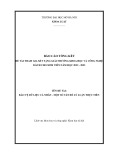
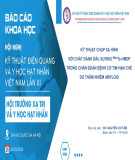

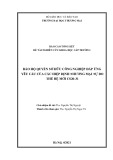
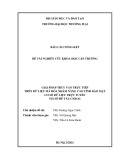
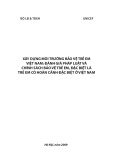
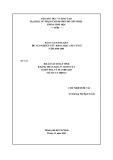
![Vaccine và ứng dụng: Bài tiểu luận [chuẩn SEO]](https://cdn.tailieu.vn/images/document/thumbnail/2016/20160519/3008140018/135x160/652005293.jpg)
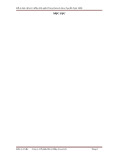
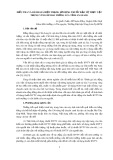
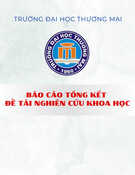




![Báo cáo seminar chuyên ngành Công nghệ hóa học và thực phẩm [Mới nhất]](https://cdn.tailieu.vn/images/document/thumbnail/2025/20250711/hienkelvinzoi@gmail.com/135x160/47051752458701.jpg)









